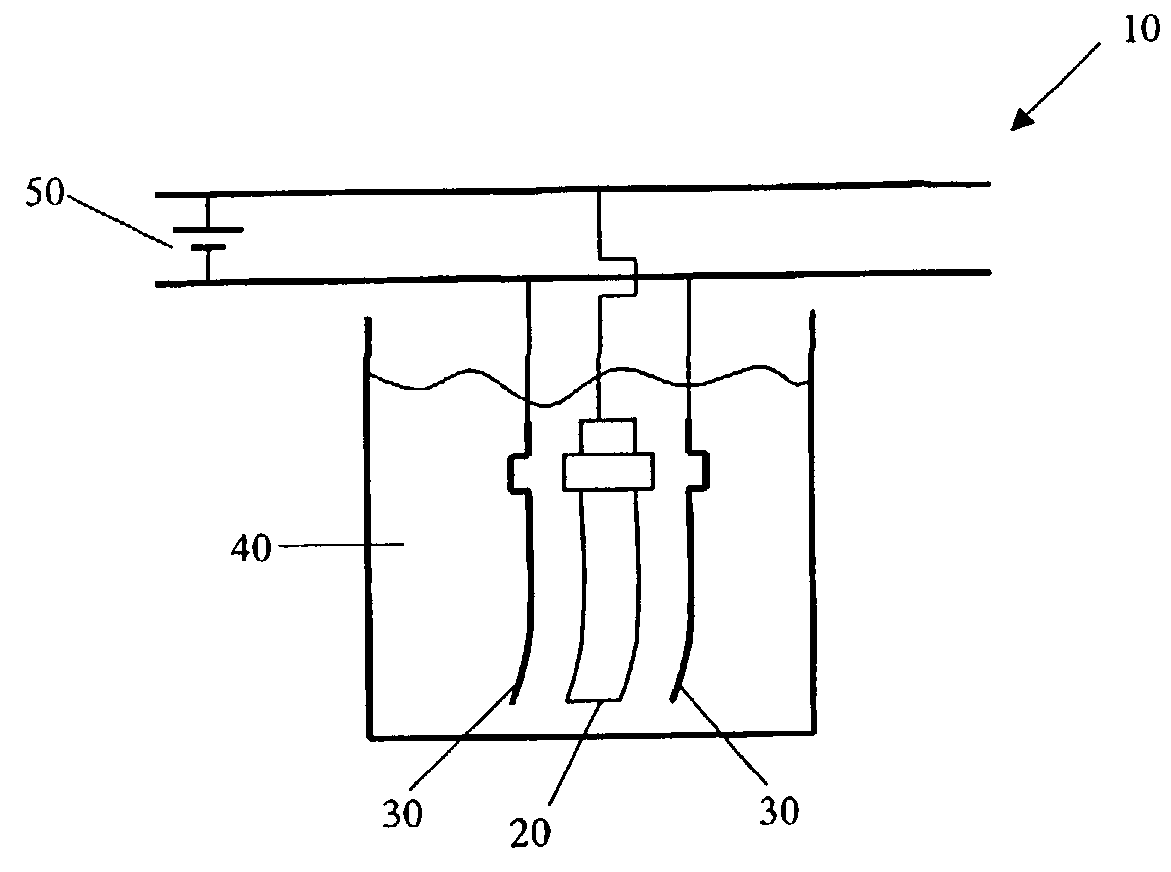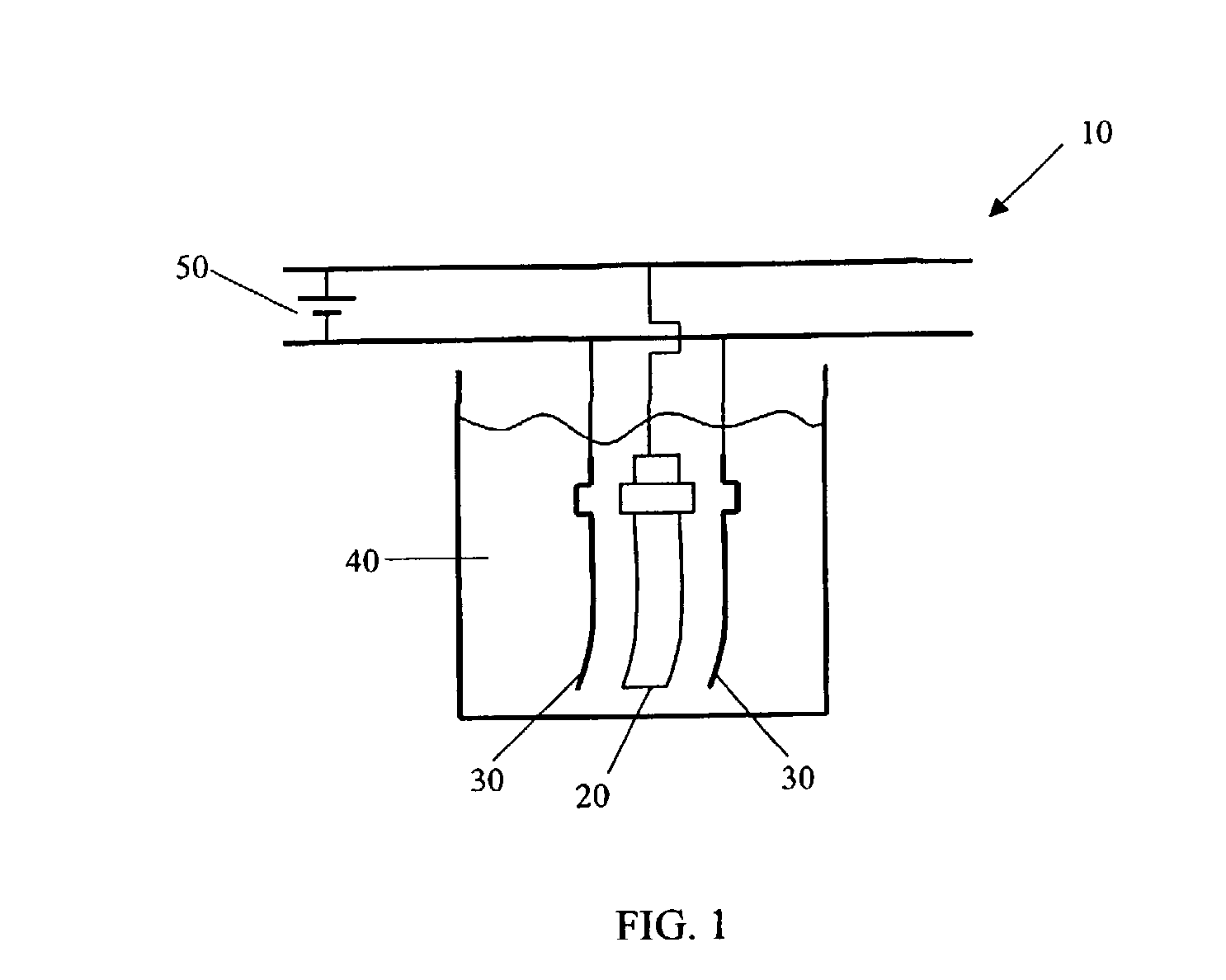Electropolishing solution and methods for its use and recovery
a technology of electrolysis solution and electrode, which is applied in the direction of electrolytic capacitors, manufacturing tools, lapping machines, etc., can solve the problems of difficult and expensive disposal, surface finishing of metals, and shaping of metals
- Summary
- Abstract
- Description
- Claims
- Application Information
AI Technical Summary
Problems solved by technology
Method used
Image
Examples
example 9
[0044] 65 milliliters (ml) spent electropolishing solution comprising ethylene glycol and potassium chloride in a 95:5 ratio by weight and 35 wt % titanium-containing solid was heated to an elevated temperature of 115.degree. C. in a glass beaker. While at the elevated temperature, the spent electropolishing solution was sparged with compressed air for one hour. Following sparging, the metal-containing solid particles began to settle. After about 20 minutes it was observed that about 20 ml of clear electropolishing solution was formed in the beaker while about 45 ml of a sediment bed remained at the bottom of the beaker.
example 10
[0045] In order to demonstrate the effectiveness of recovered electropolishing solution, spent electropolishing solution containing about 35 wt % titanium-containing solid, ethylene glycol and potassium chloride (in a weight ratio of 95:5, respectively) was mixed with water. The spent electropolishing solution to water ratio was maintained at 10:90 by weight. After distillation, the recovered electropolishing solution was reused to electropolish titanium metal and no changes in the electropolishing behavior were observed.
examples 11-13
[0046] Three metal-containing solids were prepared and analyzed for titanium, carbon, hydrogen, and nitrogen contents. An electropolishing solution containing 95 weight percent ethylene glycol and 5 weight percent potassium chloride was used to electropolish a titanium surface, producing a spent electropolishing solution with a fine, suspended solid. The spent electropolishing solution was treated three ways. For Example 11, it was filtered on 1 micron filter paper, dried, and analyzed without agitation. For Example 12, it was agitated with pressurized air for about 60 minutes at 115.degree. C., then filtered, dried, and analyzed. For Example 13, it was agitated with pressurized air for about 5 minutes at 150.degree. C., then filtered, dried, and analyzed. Before analysis, samples were dried in a vacuum oven at about 50.degree. C. to remove residual ethylene glycol. For each dried sample, carbon / hydrogen / nitrogen analyses were conducted with a Carlo Erba EA1108 Analyzer, which uses ...
PUM
| Property | Measurement | Unit |
|---|---|---|
| weight percent | aaaaa | aaaaa |
| weight percent | aaaaa | aaaaa |
| weight percent | aaaaa | aaaaa |
Abstract
Description
Claims
Application Information
 Login to View More
Login to View More - R&D
- Intellectual Property
- Life Sciences
- Materials
- Tech Scout
- Unparalleled Data Quality
- Higher Quality Content
- 60% Fewer Hallucinations
Browse by: Latest US Patents, China's latest patents, Technical Efficacy Thesaurus, Application Domain, Technology Topic, Popular Technical Reports.
© 2025 PatSnap. All rights reserved.Legal|Privacy policy|Modern Slavery Act Transparency Statement|Sitemap|About US| Contact US: help@patsnap.com


